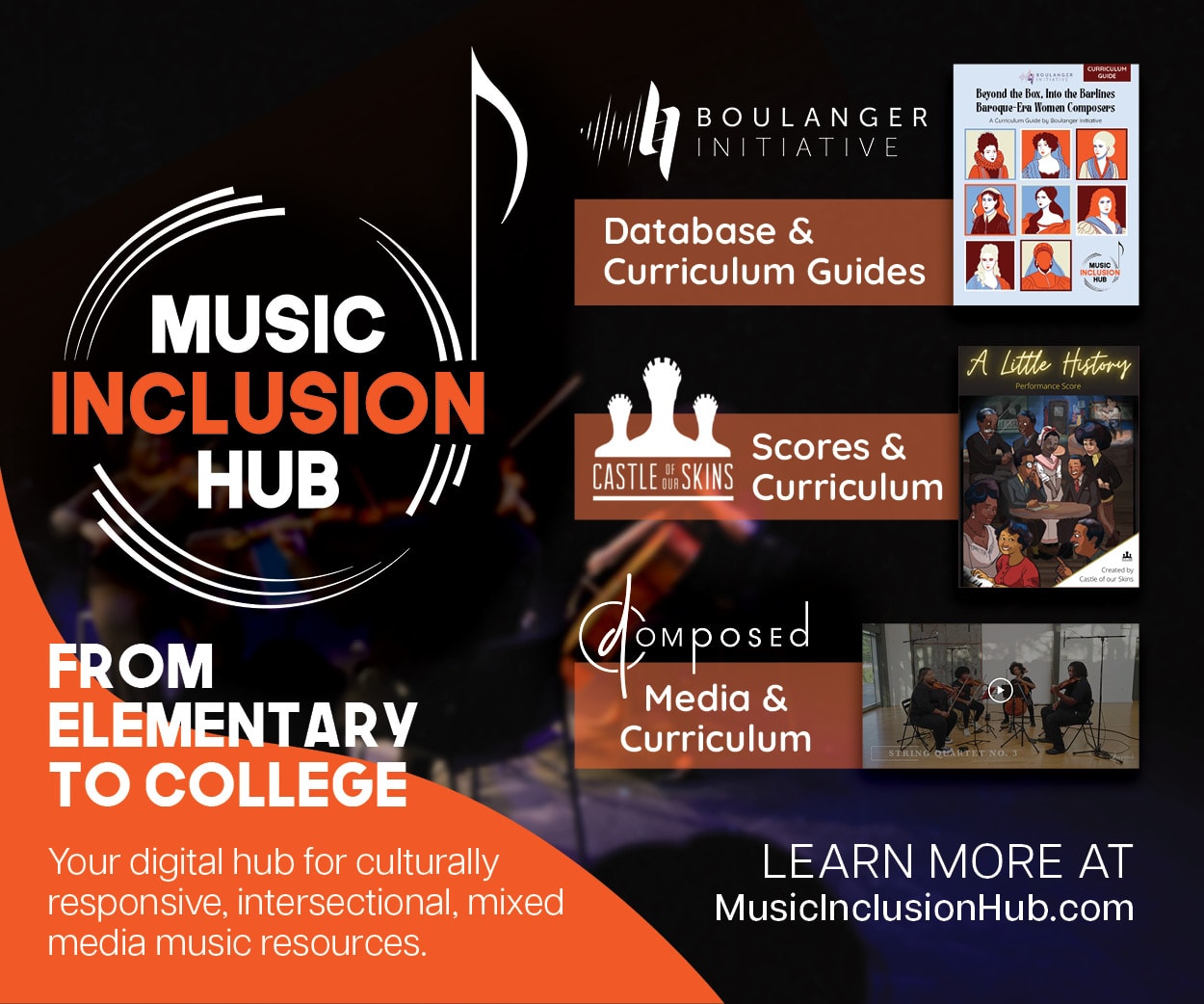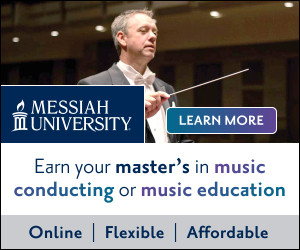/ News Posts / Online Learning in the Ensemble Class?!
Online Learning in the Ensemble Class?!
Use Technology and Distance Education to Teach Ensemble Classes Remotely
By NAfME Member Peter J. Perry, D.M.A.
The emergency school closures due to COVID-19 have pushed many school systems and teachers to use online or distance education to deliver instruction. The complexities and practicality of this varies with each content area. For example, an online discussion via Google Classroom in an English class or a student-created PowerPoint presentation for a history class, both accompanied by a video lecture through Zoom seem ideal uses of this medium.
But what about music class? What about an ensemble performance class?
There are many wonderful online and technology resources for creating music and for learning/working on music fundamentals (see below). These are applicable to a band, orchestra, or chorus class. There are also online learning strategies that specifically address the performance nature and instrument/vocal skill-building unique to ensemble classes. I want to stress that while systems are quick to jump to “online” or “distance” learning, we should remember none of these technology strategies will ever supplant the important, person-to-person human interaction, connection, and collective creation that an ensemble class provides. It contains the highest level of cognitive skill usage and interpersonal discourse in the school building. With that said, the ensemble class by its very nature is the antithesis of “social distancing.” Therefore, when necessary, the ideas below will help keep the individual and group mechanisms going until “the band gets back together again.”
“We should remember none of these technology strategies will ever supplant the important, person-to-person human interaction, connection, and collective creation that an ensemble class provides.”
NOTE: These strategies are not pandemic-specific and can also be used for other situations such as: weather closures, long-term teacher absences, and summer learning.
Generally, when you look at online learning, look at ways to have students:
- Practice their instrument or sing daily (possibly add an assessment or self-assessment)
- Assess their own ensemble performance or that of others
- Reinforce individual skills (e.g., scales/keys, rhythm-reading, sight-reading)
- Explore listening or video examples of good musical models
- Experiment with technology tools available in music (i.e., notation programs, audio editing, digital audio workstations)
Here are some short-term and long-term strategies that incorporate these ideas.
Short-Term Strategies – Quick Turnaround
- Smart Music and Practice First are both great Computer Assisted Instruction (CAI) applications for performing ensembles. These are direct ways to monitor, assess practice, and provide feedback. While both applications are offered via subscription, they also have free trials.
- If available, try to video conference a class. Google Hangouts or Zoom are popular applications. While this can get tricky with a lot of ensemble members and can be diminished with high Internet traffic, it is a great way to actually see and talk to your kids.
- Use the Media Masterclass concept I outline here to provide students with good model performances, masterclasses, and other instructional media. Listening or watching great performances on the Berlin Philharmonic Digital Concert Hall, Met Opera On-Demand (both are currently offering free trials and passes) bring great performances to the students.
- Sight-Reading Factory is a subscription-based application that lets you instantly create and assign sight-reading etudes. They offer free trials.
- musictheory.net is free and provides plenty of theory lessons, ear training, key signature and interval review.
Long-Term Strategies – Assign and Collect Later
- Have students make a personal musical journey. They can search for, listen to, and evaluate music of their choice (obviously within the ensemble class context). I never feel we spend enough time teaching our students how to listen and what to listen for. These are the foundations of building an aural concept.
- To facilitate skills, use the Performance Assessment I illustrate here and have students submit recordings of the ensemble warm-ups, skill exercises, or method book exercises. These are easy to grade and get students working on their skills.
- Have students record a solo performance of their choice. Provide some guidance but allow students to explore and find music relevant to them, prepare, record, and submit it. This helps the students buy into performing by giving them a meaningful and personal stake into the music they play.
Let’s Talk about the Virtual Ensemble
There has been a lot of talk about this idea as well as some outright discouragement of this path. Admittedly, this is the most labor-intensive strategy and requires some major technology chops. That said, this is a really cool way to incorporate technology remotely into the ensemble class. In either case, take a look and make that decision for yourself.
This project reinforces many of the instructional components that happen in an ensemble class (e.g., practicing and performing a part, music-reading, collaboration with others, etc.). The main difference is that the individual pieces are compiled after the fact instead of instantaneously in a rehearsal or performance. There are plenty of great examples on YouTube. The most well-known use is Eric Whitacre’s Virtual Choir. Additionally, there are some great tutorials to take you step-by-step if you want to pursue this idea.
Generally, this is what you do:
- Depending on the type of ensemble, post sheet music and either a click-track, accompaniment track, or an actual recording of the piece on a learning management system like Google Classroom or Canvas (a file-sharing application like Drop Box or Google Drive could work too). Make sure you abide by copyright
- Students download the music and practice the parts with the accompaniment track.
- While listening to (and following) the accompaniment track via headphones (so that only their performance is heard), students record their part on their smartphone, computer webcam, or video recorder.
- Students submit their part via the distribution system in step one.
Here is where it gets interesting. These steps vary depending on the applications you use.
- Import all the AUDIO tracks into your favorite audio editing program (GarageBand, Mixcraft, ProTools, BandLab, etc.). Line these up individually and edit as desired (add reverb, adjust individual balances, etc.). Flatten to one file and EXPORT the completed audio as a final recording.
- Theoretically, you could stop there. But to add the video component (all the individual videos of the ensemble members performing together), you need to use a video editing program. The catch here is that you really need a professional-grade program like: Adobe Premiere, Vegas Pro, or Apple Final Cut Pro X. These can play the many video tracks simultaneously. HitFilm is a free (although a donation is helpful to support this great resource) video editor that lets you do this too. In your desired program, import ALL your videos and either mute or delete their audio track.
- Once all are imported (without audio), import your previously created audio track. Sync the audio to the videos. Again, this varies depending on your application. Export the final product and share it with your students and school community.
I outline these tips as well as many other ways to use technology in ensemble teaching on my website: www.peterperrymusic.net and in my new book Technology Tips for Ensemble Teachers published by Oxford University Press. Feel free to check them out. I hope these suggestions help. Be smart, be safe, and remember, this too will pass.
Previous technology articles by Peter Perry:
- Technology Strategies to Get You a Superior Adjudication
- Technology in the Large Ensemble Classroom: New Tech to Explore for Back to School
- Technology Strategies for the Performing Ensemble Classroom
- Media Player Master Classes for the Large Ensemble Classroom
- Google Classroom for the Large Ensemble
- Taming Technology: Managing Multiple Technology Platforms & Systems in Your Music Instruction, and Taming Technology, Part II
About the author:
Peter Perry is a lifelong Maryland resident, and has traveled the world teaching and performing music. A NAfME member, he is currently in his twenty-fourth consecutive year as Instrumental Music Director at Richard Montgomery High School in Rockville, Maryland. Here he conducts the: Chamber Orchestra, Concert Orchestra, Pit Orchestra, Symphonic Band, Jazz Ensemble, Concert Band, and Marching Band. These ensembles consistently receive critical acclaim on local, state, and national levels.
is a lifelong Maryland resident, and has traveled the world teaching and performing music. A NAfME member, he is currently in his twenty-fourth consecutive year as Instrumental Music Director at Richard Montgomery High School in Rockville, Maryland. Here he conducts the: Chamber Orchestra, Concert Orchestra, Pit Orchestra, Symphonic Band, Jazz Ensemble, Concert Band, and Marching Band. These ensembles consistently receive critical acclaim on local, state, and national levels.
Dr. Perry is a strong advocate for music technology usage in the large ensemble. His doctoral dissertation, “The Effect of Flexible-Practice Computer-Assisted Instruction and Cognitive Style on the Development of Music Performance Skills in High School Instrumental Students,” focused on how the practice software, SmartMusic™, and the cognitive styles of field dependence and field independence affect musical performance skill development. His book, Technology Tips for Ensemble Teachers, published by Oxford University Press, is the first text to specifically outline technology use and instructional strategies using technology in the large Ensemble.
He holds a Doctor of Musical Arts degree in Music Education from Shenandoah Conservatory, as well as a Master of Music Degree in Music Education-Instrumental Conducting Concentration, and a Bachelor of Science Degree-Instrumental Music Education, both from the University of Maryland. While at the University of Maryland, Dr. Perry was awarded the prestigious Creative and Performing Arts Scholarship in Music.
In 2006, Dr. Perry received a Japan Fulbright fellowship and participated in the Japan Fulbright Memorial Fund Teacher Program. In 2009, Dr. Perry received the Presidential Scholar Teacher Award. In 2019, he received the Brent Cannon Music Education Alumni Achievement Award from Kappa Kappa Psi, recognizing outstanding contributions to secondary music education. In October 2019, he took a group of student musicians to Yilan, Taiwan, to perform in the Yilan International Arts Festival, representing the United States (the third American ensemble in the festival’s history). He is an active guest conductor, clinician, adjudicator, lecturer, author, composer, and performer.
Follow Dr. Perry on Twitter: @peterperry101 or at www.peterperrymusic.net.
Did this blog spur new ideas for your music program? Share them on Amplify! Interested in reprinting this article? Please review the reprint guidelines.
The National Association for Music Education (NAfME) provides a number of forums for the sharing of information and opinion, including blogs and postings on our website, articles and columns in our magazines and journals, and postings to our Amplify member portal. Unless specifically noted, the views expressed in these media do not necessarily represent the policy or views of the Association, its officers, or its employees.
Catherina Hurlburt, Marketing Communications Manager. April 2, 2020. © National Association for Music Education (NAfME.org)
Published Date
April 2, 2020
Category
- Uncategorized
Copyright
April 2, 2020. © National Association for Music Education (NAfME.org)






